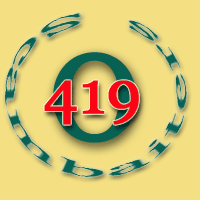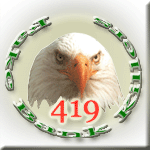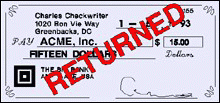
• Home •
Victim´s Story •
Fraud Prevention •
Project GSO •
Hall of Shame •
LINKS •

Tips for Tackling Check Fraud
Loss Prevention Precautions for Retailers
"NSF," "Account Closed," "Counterfeit" -- each time retailers see these words on a returned check, they know they have lost money. According to the National Check Fraud Center, check fraud and counterfeiting are among the fastest growing problems affecting the U.S. financial system.
Estimated annual losses from check fraud and counterfeiting exceed $10 billion and increase every year. There were over 3 billion re-presented check entries processed through the automated check clearinghouse network in the fourth quarter of 2000, according to the National Automated Check Clearing House Association.
Checks account for approximately one-third of retail spending and they are one of the most popular form of payment, second only to cash. Because of their popularity retailers cannot afford to lose business by refusing to accept checks.
However there are some precautions retailers can take when accepting checks that will help combat check fraud.
TeleCheck, a leading provider of check services, offers these recommendations to combat check fraud:
- Establish a check acceptance policy detailing acceptable forms of ID, required information and dollar limits and make no exceptions to the policy.
- Fraud artists are skilled at creating hassles or confusion that can leave businesses stuck with a bad check.
- When accepting a check, make sure a name, address and phone number are printed on the check and the written and numeral amounts correspond.
- Pay attention to the "feel" of the check; most check paper has the same weight and texture.
- Watch the check-writer sign the check and have the customer print the name below, if the signature is illegible.
- Compare the signatures, photo and physical description of the ID with that of the check writer.
- Check the driver's license, which should be smooth all over with no ridges that indicate an alteration or modification. Verify that the ID is still valid.
- Ninety percent of returned checks have low check numbers (100 to 500).
- While low check numbers indicate a recently opened account and a potentially more risky check, particularly for business or dba ("doing business as") checks, that is not always the case.
- More useful information on the check is the account's opening date (month and year), usually indicated by four numbers to the side of the account holder's name and address.
- Don't accept second-party or third-party checks.
- The four-digits following the magnetic ink character recognition (MICR) number at the bottom of the check should match the four-digit number at the top right hand of the check.
- All checks, except government checks, should have a perforation along one side of the check.
- You can try calling the financial institution to confirm if funds are available, but there is no guarantee that the check will clear.
- Use a check guarantee or verification service.
What Check 21 Means to Your Business
Any business operating a business deposit bank account in the U.S. must know the implications of Check 21. Learn what your business needs to know about the new act.
What is Check 21?
Check 21 or "The Check Clearing for the 21st Century Act" was passed into law on October 28, 2003, and effective on October 28, 2004. Check 21 creates a new digital product called the substitute check. The substitute check has a paper reproduction of the original check's image from the front and back.
The new Check 21 act means an improvement in efficiency for the banking system. No more shipping original checks around the country. It has yet to be seen if the added savings for banks will be passed off to consumers.
What Does Check 21 Mean to My Business?
New Proof of Payment: If your business needs to confirm payment from a customer, under the new Check 21 Act a substitute check is the legal equivalent of the original and acceptable proof.
The IRS can even accept the new check form as proof of payment.
Shorter Float Time: The float time is the period between the time a check is written and the time it clears. With the new efficiency in check processing times, business owners can expect checks to clear in days or even minutes. "Floating" your checks for one or two days can result in disaster:
- more fees in bounced check charges
- negative image on your credit rating
- embarrassment in dealing with suppliers or customers over bad checks
To offset the quicker processing time, make certain the cash is in your account before you write a check. Also, ensure you have adequate account overdraft coverage until you adjust to the new system. Don't expect to get your money faster. The law doesn't amend the hold times on your account.
Change in Mailed Statements: Companies receiving original checks returned in the mail might notice a substitute check instead. Retain the substitute as if it was the original because it represents the legal equivalent.
Reduced Fraud: In theory, Check 21 can reduce losses from check fraud because the electronic check processing will help the bank receive and detect fraudulent checks earlier. It doesn't mean you should drop your guard on fraud. Just be aware another safeguard is in place.
For more information on Check 21, visit the Federal Reserve and contact your bank for details on how your account is impacted.
Check Fraud - Important guidelines
It is important that all businesses accepting checks, especially in these trying economic times, establish an effective check policy for both customers and employees. Employees who are properly trained in check acceptance policies will help protect from bad check losses. It is a good idea to have check acceptance policies easily accessible to cashiers, clerks, and others responsible for accepting checks. Customers of businesses with established and conspicuously displayed check acceptance policies will feel they are being dealt with fairly if all customers are dealt with in a consistent manner.
Below are some guidelines for accepting checks, and what to do if you are the victim of check fraud.
Identification
Failure to obtain proper identification is the most common reason why bad check cases are found to be non-prosecutable. All forms of I.D. can be forged. Therefore, it is important to view identification in terms of "acceptable risk."
To minimize this problem, require at least one primary I.D., preferably backed by at least one secondary I.D. It is vitally important to compare the photo and physical description on the primary I.D. card to the person writing the check.
-Primary I.D.'s are: (must have a laminated photo and always check for alterations)
-Driver's license (do not accept a temporary license)
-State identification card
-Military I.D. card (check rank/grade and expiration date)
-Employee I.D. card (check for alterations)
Secondary I.D.'s are:
-Check guarantee card (check expiration date and maximum amount of coverage)
-Major credit cards and oil companies (check expiration dates)
Never accept:
-Social Security cards
-Membership cards
-Library cards
-Temporary driver's licenses
-Any card or I.D. that appears to be altered
Acceptance Procedure
A. Is the check dated with today's date?
Pre- or post-dated checks cannot be prosecuted and should be cause for suspicion.
B. Is the signature legible? Was it signed in your presence?
Do not accept checks that have been previously signed. The signature must be made in the presence of the person accepting the check and should match the writer's photo I.D. In the case of company checks, it is vital that the signature is legible. If not, print the individual's name on the front of the check.
C. Is the check written on a new account?
Approximately 85% of all bad checks are written on accounts only a few months old and bearing check numbers between 101 and 150. Use caution - possibly verify funds with the bank for large amounts. Do not accept counter-drafts. Only accept checks with the name and address imprinted on them.
D. Do written amounts and numbers correspond?
Banks will not honor checks with discrepancies between written amounts and numbers.
E. Is the address complete?
Require a street address in addition to a P.O. Box number. Ask "What is your current address?" Request home and/or work telephone numbers.
F. Can you confirm the identity of the check writer?
Compare and record primary and secondary I.D. information (see Section I). Record the information on the front of the check to avoid the possibility of bank processing stamps covering important information. Record the birthdate, address, phone numbers, driver's license number or any other pertinent information.
G. Did the person accepting the check initial the check?
Identify the person who accepted the check as that person will be a necessary witness in the event of a criminal case.
Important Points
A. Use common sense. If in doubt, call the bank and verify that the check is good before accepting it.
B. Be doubly cautious on weekends and holidays.
C. Do not permit yourself to become flustered by the shopper who is in a rush - be courteous, but be careful.
D. Consider accepting only local checks. A bad check drawn on an out-of-state bank may have an adverse effect on collection and prosecution efforts.
E. Do not accept two-or-more party checks.
F. Do not accept checks with alterations.
G. Once in place, DO NOT MAKE EXCEPTIONS TO YOUR POLICY AND PROCEDURES.
Recovery/Restitution
If you do receive a bad check, you can file a Bad Check Complaint by contacting the Marin County District Attorney Bad Check Program at 866-801-4883 .
© 2006-2010 by GSO • Contact
